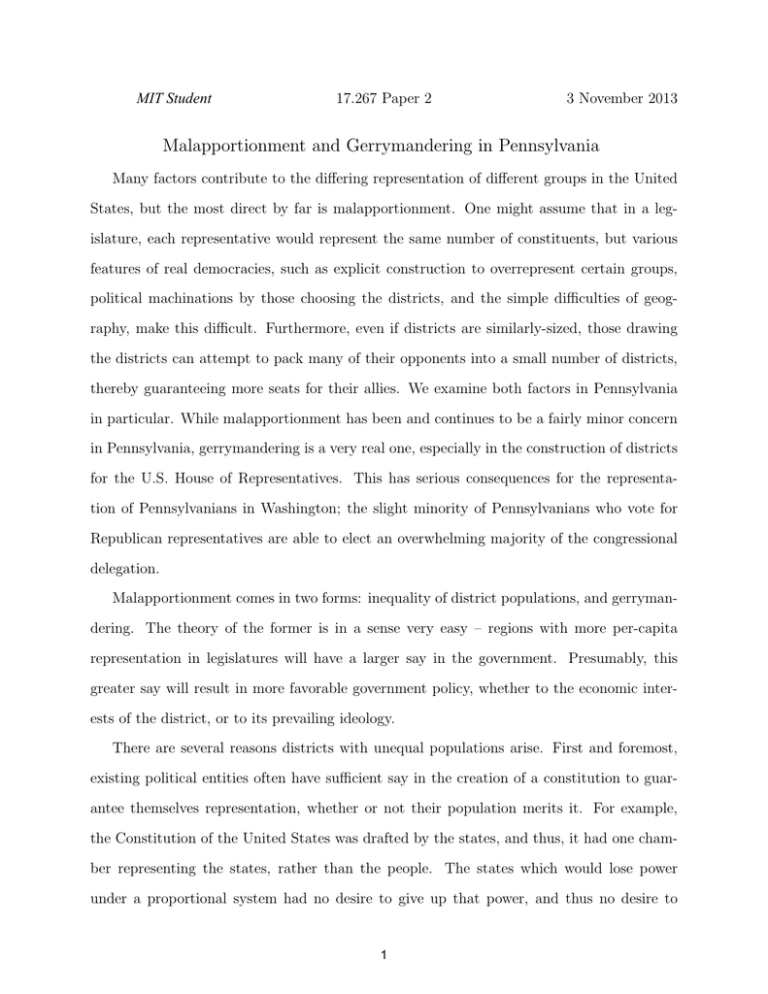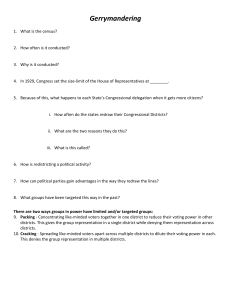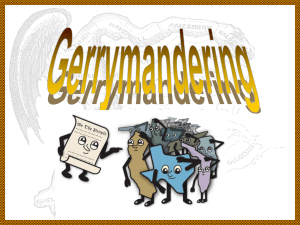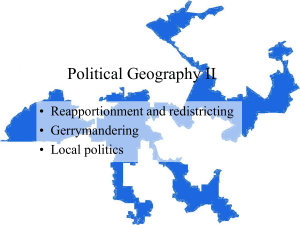Malapportionment and Gerrymandering in Pennsylvania MIT Student
advertisement

MIT Student 17.267 Paper 2 3 November 2013 Malapportionment and Gerrymandering in Pennsylvania Many factors contribute to the differing representation of different groups in the United States, but the most direct by far is malapportionment. One might assume that in a legislature, each representative would represent the same number of constituents, but various features of real democracies, such as explicit construction to overrepresent certain groups, political machinations by those choosing the districts, and the simple difficulties of geography, make this difficult. Furthermore, even if districts are similarly-sized, those drawing the districts can attempt to pack many of their opponents into a small number of districts, thereby guaranteeing more seats for their allies. We examine both factors in Pennsylvania in particular. While malapportionment has been and continues to be a fairly minor concern in Pennsylvania, gerrymandering is a very real one, especially in the construction of districts for the U.S. House of Representatives. This has serious consequences for the representation of Pennsylvanians in Washington; the slight minority of Pennsylvanians who vote for Republican representatives are able to elect an overwhelming majority of the congressional delegation. Malapportionment comes in two forms: inequality of district populations, and gerrymandering. The theory of the former is in a sense very easy – regions with more per-capita representation in legislatures will have a larger say in the government. Presumably, this greater say will result in more favorable government policy, whether to the economic interests of the district, or to its prevailing ideology. There are several reasons districts with unequal populations arise. First and foremost, existing political entities often have sufficient say in the creation of a constitution to guarantee themselves representation, whether or not their population merits it. For example, the Constitution of the United States was drafted by the states, and thus, it had one chamber representing the states, rather than the people. The states which would lose power under a proportional system had no desire to give up that power, and thus no desire to 1 MIT Student 17.267 Paper 2 3 November 2013 ratify any new constitution not enshrining the states as entities. (Dahl 2001, 46–54) Once a system of government is formed, those with power aim to keep it, so any inequalities in representation tend to persist. By deliberately apportioning seats unequally, or simply by failing to reapportion seats as populations change, legislatures can give more representation to whichever geographic, and often thus demographic and ideological, constituencies they wish. (Ansolabehere and Snyder 2008, 54–61) In many constitutions, some form or level of population equality for districts is required. For example, in Baker v. Carr, the Supreme Court held that, under the equal protection clause of the Fourteenth Amendment, unequal representation by population in Congressional districts was unconstitutional. In such cases, legislators often resort to gerrymandering, that is, drawing districts shaped not to represent geographic constituencies, but to advantage certain legislators or parties. For example, incumbent parties often attempt to pack their opponents into a few districts, while spreading out their supporters among the remainder, to increase the number of seats they can hold. Incumbent legislators also compete to make their own districts safer. This results in districts with strange shapes and no resemblance to traditional geographic or political boundaries. (Altman 1998) In practice, numerical malapportionment in the U.S. House of Representatives and state legislatures is basically a problem of the past. Before Baker v. Carr, legislative district populations varied wildly within each state, sometimes by ratios as high as 600 to 1; even the typical state had inequalities on the order of 20 to 1. By the end of the 1960s, the landscape had completely changed. Ansolabehere and Snyder describe how these gross inequalities were completely eradicated by the end of the decade. (Ansolabehere and Snyder 2008, 23– 31, 187–188) In Pennsylvania, even before Baker v. Carr, malapportionment in the state General Assembly was fairly limited. Using a more sophisticated statistical framework than Ansolabehere and Snyder, Press and Schubert ranked Pennsylvania seventh-best of the states 2 MIT Student 17.267 Paper 2 3 November 2013 in apportionment, with a score of 70.8 on a scale of 100; for comparison, Massachusetts was best with a score of 96.3, the U.S. as a whole was at 34th with 39.5, and Indiana was worst with −4.3. (Schubert and Press 1964) Today, the differences district-to-district are fairly small; in the 2011 redistricting, the most populous House district was the 71st with 65036 members, while the least populous was the 21st with 60110 members, a difference of under 10%; the numbers for the Senate and the U.S. House were similarly close (PA Legis. Data Proc. Center 2012a; 2012b; Census Bureau 2011). Gerrymandering, on the other hand, is alive and well in Pennsylvania. State House and Senate districts are decided by a commission consisting of the Senate and House Majority and Minority Leaders, plus a chair elected by those four, or chosen by the Supreme Court if no chair can be elected. Boundaries must follow municipal and county lines when possible. Because of these controls, gerrymandering in the maps appears fairly limited although still present; the maps are Figure 1 and Figure 2. For example, while the 49th senate district is geographically compact, the 20th just circumscribes both Scranton and Wilkes-Barre. However, these deviations are minor when compared to those of the congressional districts. The districts for U.S. House elections are chosen by the legislature in the normal legislative process, and they include examples of nearly every classic gerrymandered shape. (The map is Figure 3.) The 12th district has the classic “dumbbell” shape, and the 7th district splits up not only counties, but municipalities and even wards. These claims are borne out by the 2012 election results. Statewide, the votes were almost exactly split, with Democrats receiving 50.7% of the two-party vote, but only five of the eighteen elected representatives were Democrats. This is because the average winning Democrat won 76.3% of the two-party vote, while the average winning Republican won only 59.5%, a clear sign of a gerrymander designed to create reasonably safe districts for Republicans while packing Democrats into a few very skewed district. In only one district (the 12th ) did the winning candidate receive less than 57% of the vote. (PA Dept. of State 2012) If similar misrepresentation is 3 MIT Student 17.267 Paper 2 3 November 2013 repeated across the nation, the results are worrying indeed. In short, Pennsylvania has few problems with unequal representation by population; even before Baker v. Carr, it had a less malapportioned legislature than most other states, and today the districts vary by around 10%. The state General Assembly districts show only limited evidence of gerrymandering, suggesting that the fact that they are chosen by a bipartisan commission and approved by the state Supreme Court does make a difference. The U.S. House districts, on the other hand, are very clearly gerrymandered to the benefit of the Republican Party; this is no surprise, as they are chosen by the normal legislative process, currently controlled entirely by the Republicans. Especially after Vieth v. Jubelirer upheld partisan gerrymandering in Pennsylvania, this is very concerning; a minority of Pennyslvanians was able to select more than two thirds of its representatives in Washington. Luckily, it suggests a clear solution: use the process for state legislative districting to choose congressional districts; it remains to be seen whether such a change is politically feasible. References Altman, Micah. 1998. Traditional districting principles: Judicial myths vs. reality. Social Science History 22 (2): pp. 159–200. Ansolabehere, Stephen, and James M. Snyder Jr. 2008. The end of inequality. New York: W. W. Norton & Company. Dahl, Robert A. 2001. How democratic is the U.S. constitution? New Haven: Yale University Press. Pennsylvania Department of State. 2012. General election official returns. Pennsylvania Legislative Data Processing Center. 2012a. Composite listing of House of Representatives districts. ———. 2012b. Composite listing of Senate districts. Pennsylvania Legislative Reapportionment Commission. 2013. Pennsylvania redistricting: Interactive district maps. Schubert, Glendon, and Charles Press. 1964. Measuring malapportionment [in English]. The American Political Science Review 58 (2): pp. 302–327. U.S. Census Bureau. 2011. American Community Survey 1-year estimates. 4 MIT Student 17.267 Paper 2 3 November 2013 Content removed due to copyright restrictions. To view Figure 1, go to: http://aws.redistricting.state.pa.us/Redistricting/Resources/GISData/Districts/Legislative/House /2011-Revised-Final/PDF/2011-Revised-Final-Plan-Map-House.pdf Figure 1: Pennsylvania House districts after the 2011 redistricting. (PA Legis. Reapportionment Comm. 2013) Content removed due to copyright restrictions. To view Figure 2, go to: http://aws.redistricting.state.pa.us/Redistricting/Resources/GISData/Districts/Legislative /Senate/2011-Revised-Final/PDF/FinalSenatePlan2012.pdf Figure 2: Pennsylvania Senate districts after the 2011 redistricting. (PA Legis. Reapportionment Comm. 2013) Content removed due to copyright restrictions. To view Figure 3, go to: http://www.redistricting.state.pa.us/Resources/GISData/Districts/Congressional /2011/PDF/2011-PA-Congressional-Map.pdf Figure 3: U.S. House districts after the 2011 redistricting. (PA Legis. Reapportionment Comm. 2013) 5 MIT OpenCourseWare http://ocw.mit.edu 17.267 Democracy in America Fall 2013 For information about citing these materials or our Terms of Use, visit: http://ocw.mit.edu/terms.






